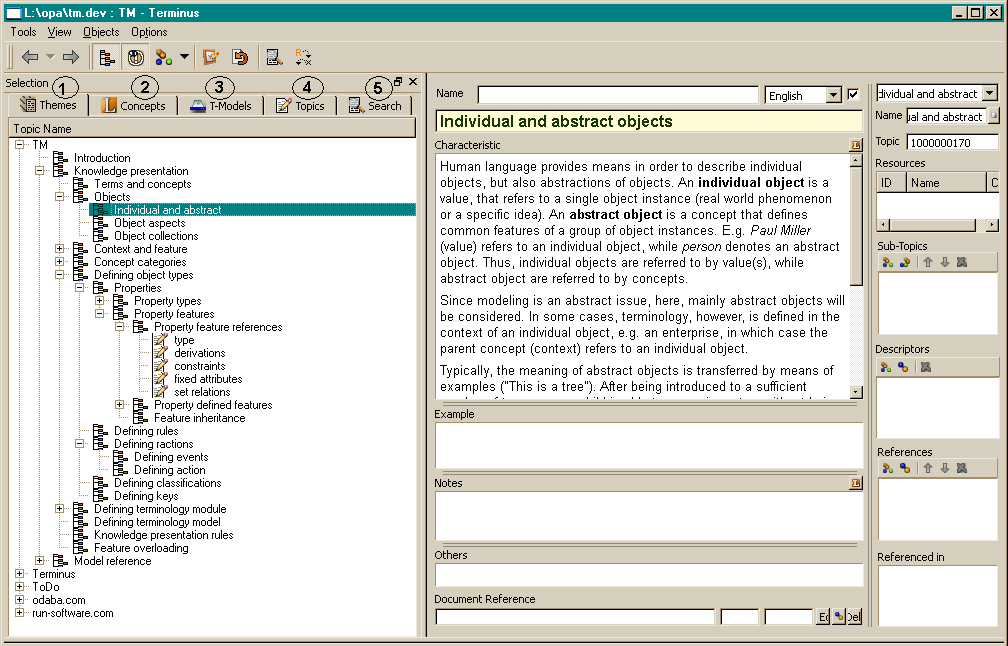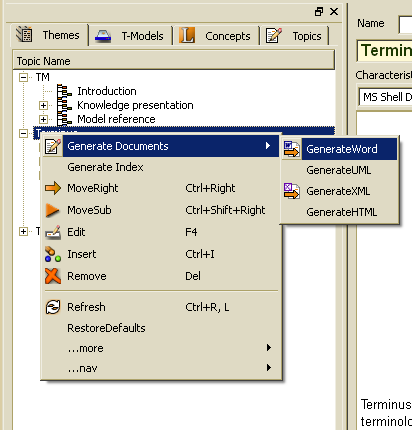Terminus application
Terminus supports defining expert knowledge on different levels. In order to get precise information about expert knowledge, the structure of the terminology model helps to store the right information on the right place.
Usually, the first step is analyzing the problem and shortly describing the solution in a thematic hierarchy. A number of relevant concepts and terms result from this definition as being used by subject area experts. In the next phase simplified concept definitions are described in detail as terminology model object types or global features (e.g. processes). Getting the details for terminology model object types is the next step. Here, experts are requested to define properties for the different object types. Names for properties are defined by the experts, who know best the proper names for these details.
Usually, it is a good idea, to separate definitions of characteristics from the more advanced behavior or reaction definitions. Sometimes, however, rules or reactions are discussed when defining characteristics, and might be defined in this case as well.
Often, definitions of characteristics result in new object types, which require characteristics definitions again. Moreover, generalizations defined in the concept system may change and become more specific. Thus, the concept system should be maintained in parallel or has to be reviewed later in order to obtain the precise terminology definition for the concepts referenced.
In order to describe complex processes or contexts of a subject area, but also in order to define user's guides like this document, the themes hierarchy may be used again for creating structured documents.
Terminus supports generating different sorts of output from the terminology model, concept system and themes list. Open Office or Microsoft word documents can be created as well as WEB documentation in form of HTML sites (as the online documentation for Terminus).
Developing a terminology model may directly start with the terminology model definition. It is suggested, however, to begin with problem analysis, which might be described in a topic hierarchy (Themes).
From the problem analysis one gets the most relevant concepts and terms (Concepts), which should be defined in the next step, i.e. the meaning of concepts and terms should be defined as being used by subject area experts. Often, defining the terminology model is a mix between defining concepts and terminology model object types. In any case, each terminology model object type should get a short concept definition in order to provide a short overview.
In order to supports different definition phases for developing a terminology model, terminus provides different views to the terminology model database:

- Themes view - Provides a view to thematic documentation
- Concepts view - Provides the concept system view for defining concepts and concept relations
- T-Models view- Provides the terminology model view for defining models and object types
- Topics view - Provides a topic view for experienced users
- Search vie - Supports keyword and full text search for topics, but also for concepts and notices
 Some tools have been made available via the tools menu in the Terminus application. Other tools or features might be called from the context menu.
Some tools have been made available via the tools menu in the Terminus application. Other tools or features might be called from the context menu.
Terminus provides several features for generating word or HTML documents. In order to create a document output for a part of the hierarchy, one of the following options might be selected.
Similar tools are provided in the terminology model tre, where one may create documentation for a complete terminology model, a single object type or a class. Documentation can be provided in general as MS Office or Open Office document.
Terminus also provides translation support. Index service in order to create keyword indexes for the document topics is provided as well as search functions including keyword and full text search.
Several tools are provided via the Tool menu in the Terminus main menu. Other tools are available as command line tools.

